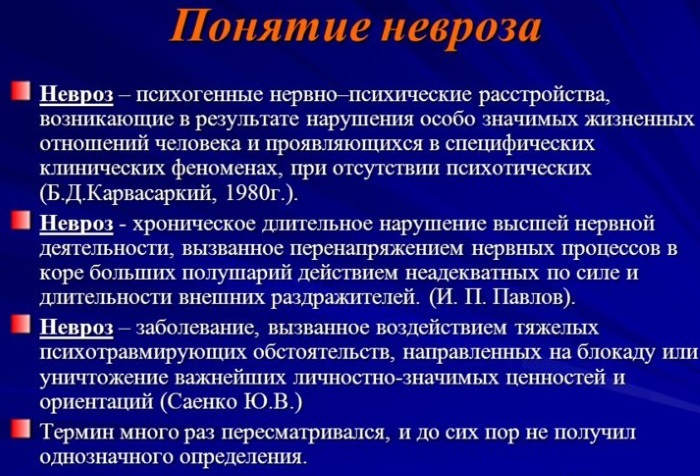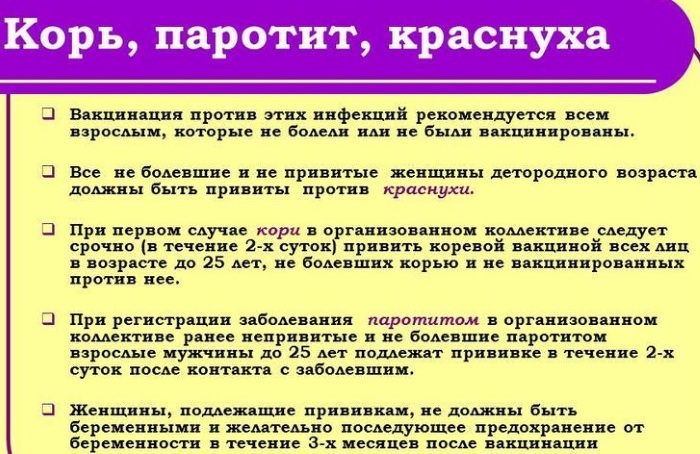Content
- The value and function of the human musculoskeletal system
- The structure of the musculoskeletal system
- Bones
- Musculature
- Anatomy of the musculoskeletal system, functions of its elements
- Human skeleton
- Spine
- Upper limbs
- Lower limbs
- Ribs
- Scull
- Connecting bones
- Muscle
- Diseases of the musculoskeletal system
- Ankylosis
- Arthritis
- Dystrophy
- Osteoporosis
- Scoliosis
- Flat feet
- Video about the musculoskeletal system
Functions of all elements musculoskeletal system are aimed at ensuring that a person has the opportunity to independently perform active actions with the upper and lower limbs, to carry out head turns, torso tilts in different directions, synchronize your movements in conditions of physical exertion and work.
The value and function of the human musculoskeletal system
The functional purpose of the human musculoskeletal system is to activate the work of the bones of the skeleton, joints, muscles, connective tissue body for organizing motor actions, controlling facial expressions, maintaining stable performance of internal organs, as well as life support systems organism. The musculoskeletal system is closely associated with the central and peripheral nervous system.
Allocate the functions of the human musculoskeletal system:
- fixation of the muscle tissues of the skeleton and most of the internal organs;
- performing simple movements that are necessary for independent movement along a given route, maintaining correct posture, level legs while walking;
- shock absorption during falls, jumps from great heights and shocks from other people;
- protection of tissues of vital internal organs from critical injuries in extreme situations (heart muscle, central nervous system, spinal canal, lungs, arterial vessels);
- the creation of new blood cells in the structure of the red bone marrow;
- metabolism of minerals;
- regeneration of individual fragments of bone tissue that has been damaged as a result of severe trauma.
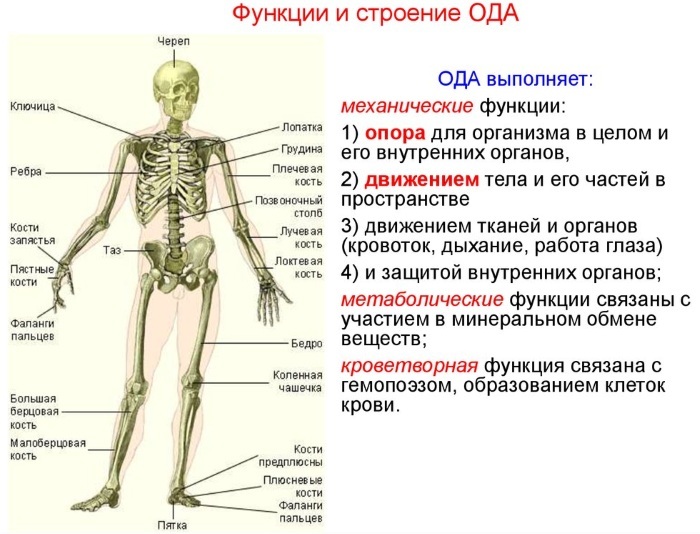
The human musculoskeletal system, the functions of which are key to maintaining the normal life of the whole organism, takes an active part in organizing the exchange of mineral salts, hematopoiesis and blood circulation in all parts of the skeletal musculature.
The structure of the musculoskeletal system
The basis of the musculoskeletal system is formed by the bones of the skeleton and its muscle tissues, which contract synchronously during active movements. Bone tissue and musculature have their own distinctive features of the anatomical structure.
Bones
The structural unit of bone tissue, regardless of the area of its location in the human body, is the osteon. This is a structural element that looks like a microscopic plate, connected with exactly the same identical "puzzles" of incredible strength. There are internal and external osteons.
All plates contain a large amount of collagen fibers and bone substance of protein origin, which is saturated with a high concentration of mineral components. The internal osteon is the basis for the formation of the Haversian canal. It is a cavity in the bone structure that acts as a natural reservoir for blood vessels and peripheral nerves.
Each osteon includes 4 to 20 plates that form an additional cavity for osteocyte cells. The skeletal system of the human body is expelled by internal and external general plates.
Their structure contains numerous channels that connect the periosteum with peripheral nerve fibers and blood vessels. Human bone tissue is classified into spongy and flat. The skeleton of the arms and legs, vertebrae, chest, small bones in the feet have a spongy structure. The pelvis, scapula, and also the skull are created from flat type bone tissue.
Musculature
The human musculoskeletal system, the functions of which ensure the performance of all departments organism, includes skeletal muscles that contract under the influence of nerve impulses systems. Each muscle fiber is an independent physiological unit with the ability to perform autonomous actions.

Muscle cells are covered with a layer of elastic membrane called sarcolemma, which is nourished by collagen and elastin. The presence of this structural unit allows the human body to show miracles of flexibility, and also prevents muscle tissue rupture during critical loads.
Each sarcolemma of muscle tissue contains a plurality of tiny filaments of myofibrils, the formation of which occurs from separate structural units of sarcomeres. The finest filamentous actin fibers and thick myosin rods form a multinucleated cell.
Actin contains about 375 different amino acids, which ensure the rapid development of skeletal muscles. On average, 65% of muscle protein is myosin. In men, skeletal musculature occupies 42 to 47% of the total body weight. In women, this indicator is in the range of 30-35%, depending on the type of body structure and diet.
Anatomy of the musculoskeletal system, functions of its elements
The human musculoskeletal system, the functions of which are important for the full functioning of the body, consists of the bones of the skeleton, muscles and tendons.
Human skeleton
The human skeleton is a set of structural elements of the musculoskeletal system, consisting of large and small bones of the flat and spongy type. The development of bone tissue of any kind comes from the mesenchyme.
Spine
The vertebral column is a supporting element of the human skeleton, which consists of 33-34 vertebrae, fastened together in the vertical direction by intervertebral discs.
This part of the musculoskeletal system is divided into the following sections:
- lumbar (includes 5 vertebrae);
- cervical (consists of 7 supporting vertebrae);
- coccygeal (contains from 3 to 5 vertebrae);
- sacral (formed from 5 vertebrae);
- thoracic (has a structure of 12 vertebrae).
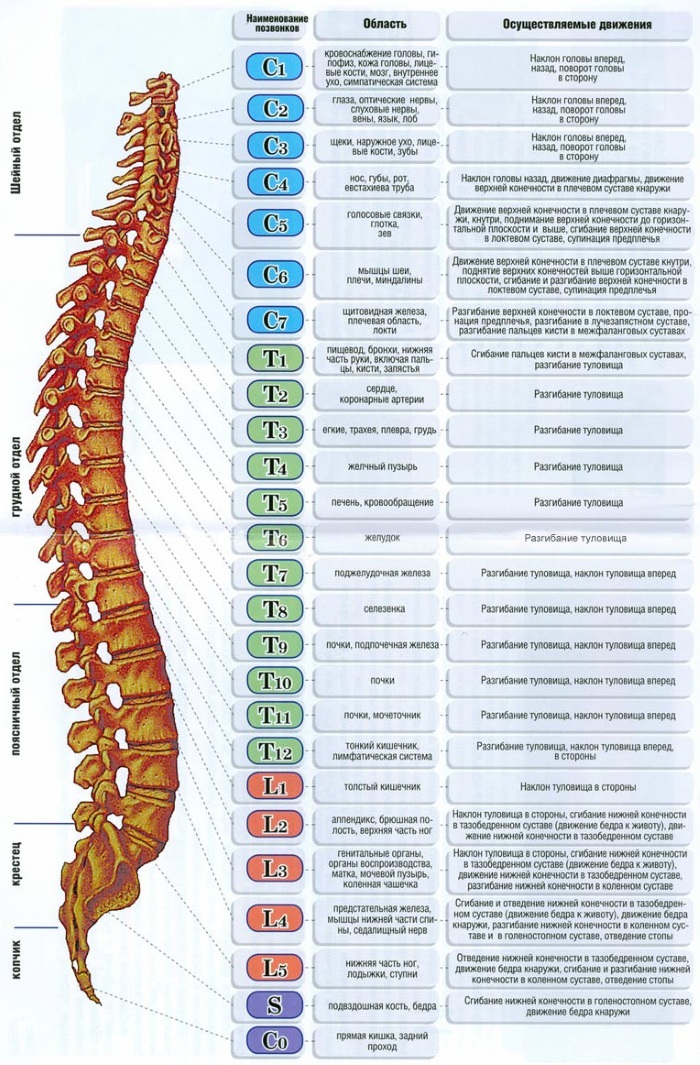
The spinal column performs the following physiological functions:
- protects the spinal canal from damage;
- is a support for other structural elements of the skeleton;
- takes a direct part in the movement of the entire body, arms, legs, performs head turns.
All parts of the spinal column have a different bending angle. This is necessary to maintain balance and balance during active movements that require dexterity and the activation of a large number of skeletal muscles.
Inside the spinal column are blood and lymph vessels, nerve endings, and the spinal cord. The first rudiments of the formation of the spine appear on the 5th week of intrauterine human development. At this time, cartilage tissue is formed, on the basis of which a chain of vertebrae and intervertebral discs is built.
Upper limbs
The upper limbs are a combination of bone tissue, muscles of the skeleton of the right and left arms.
This section of the musculoskeletal system consists of the following bones:
- elbow (including the joint);
- acromion;
- scapula;
- scaphoid;
- metacarpal;
- scapular;
- capitate;
- beam;
- collarbone;
- hook-shaped;
- palmar surface;
- phalanges of the fingers;
- bone tissue of the trapezoid;
- crescent.
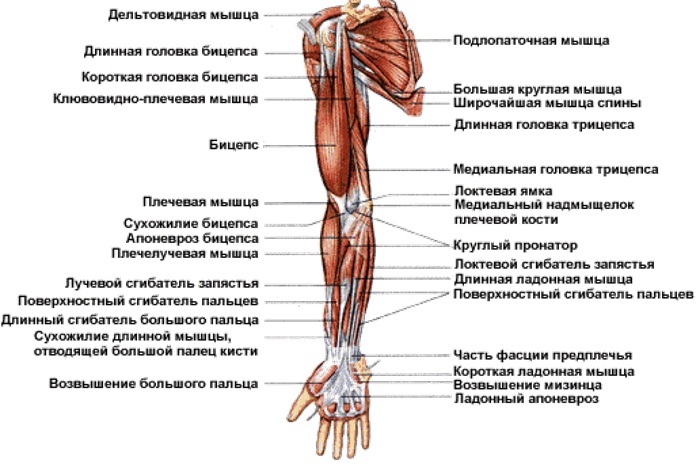
The scapula and collarbone form the girdle of the upper limbs. All functions of this part of the human musculoskeletal system are aimed at ensuring the mobility of the hands, performing flexion and extension movements in the elbow joints, all-round rotation of the upper limbs in the area shoulders. The functional mobility of the phalanges of the fingers makes it possible to carry out grasping actions, go in for sports and physical labor.
Lower limbs
The lower limbs are an integral part of the human skeleton, which is represented by the following bones:
- pelvic;
- patella;
- femoral;
- tibial;
- acetabulum;
- iliac crest;
- fibular;
- ischial notch and its bone.
The lower limbs are designed to enable a person to move independently in the environment. A static load of the whole body is created on the bone of this section of the musculoskeletal system. Due to this, the bone tissue and joints of the legs are more massive and have a high level of strength.
The foot and phalanges of her fingers have practically lost their grasping function. Currently, this part of the lower limbs is characterized by a vaulted structure and absorbs shocks during fast walking or running. The hip and knee joints are responsible for flexion and extension of the legs, as well as tilting the body forward and in different directions.
Ribs
In humans, there are 12 pairs of ribs that have an arched shape, going in the direction from the spine to the tissues of the sternum. In fact, this section of the musculoskeletal system forms the basis of the chest.
All ribs are divided into 3 segments, namely:
- the posterior part, which is represented by the neck, longitudinal ridge and bony tubercle;
- costal body;
- the front part, which smoothly passes from bone to cartilaginous tissue.
The rib body is characterized by the presence of an outer and an inner surface. The outer part of the bone has a more convex shape, and the inner part is concave towards the organs of the chest. In the bone structure of the ribs there is a red bone marrow, and from the side of their inner surface there is a small groove in which nerve endings and blood vessels are concentrated.
The anterior, middle and posterior scalene muscles are attached to this part of the musculoskeletal system. The dense rib cage protects the lungs, heart, large blood vessels from critical damage during impacts, falls, collisions with various environmental objects.
Scull
The human skull is a skeleton of the bones of the head, which has the following functional significance:
- serves as a physiological receptacle for the upper digestive system, sensory organs and brain;
- connects with the spine and takes an active part during the synchronization of movements of all parts of the musculoskeletal system;
- protects peripheral nerves and brain tissue from damage.
The human skull is formed by the articulation of 23 bones.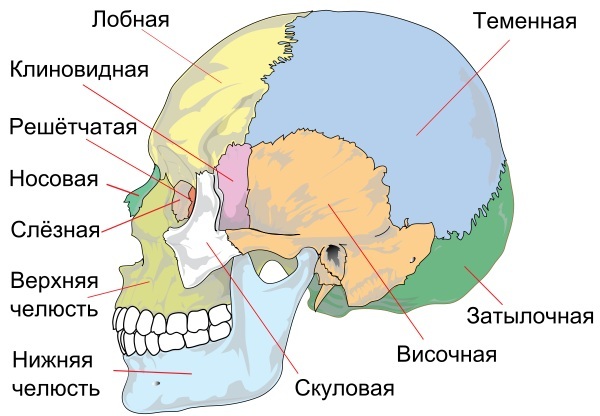
The anatomical structure of this part of the musculoskeletal system consists of the following elements:
- inner and outer base of the skull;
- infratemporal and temporal fossa;
- nasal cavity;
- bone palate;
- eye socket;
- pterygopalatine fossa.
The bones of the medullary part of the skull include the following lobes:
- parietal;
- frontal;
- occipital;
- wedge-shaped;
- temporal;
- lattice.
The facial bones are also an integral part of the skull, which consists of the following elements:
- upper jaw;
- nasal bone;
- lower jaw;
- opener;
- hyoid bone;
- lacrimal bone;
- cheekbone;
- turbinate;
- palatine bone.
In terms of the volume of bone tissue, the cerebral section of the skull significantly predominates over the facial region. The upper and lower jaw act as a base for the formation of deciduous and permanent teeth. Almost all the bones of the skull are articulated with fibrous sutures. Only the tissues of the lower jaw are attached by the mandibular joint, which is characterized by a high level of mobility, but at the same time is very vulnerable to mechanical injury.
Connecting bones
The human musculoskeletal system, the functions of which are necessary for the implementation of independent movements, includes connective tissue. These are tendons, cartilages, joints of the upper and lower extremities. The cranial bones are interconnected by the jagged edges of each segment of the skull, which form a tight lock.
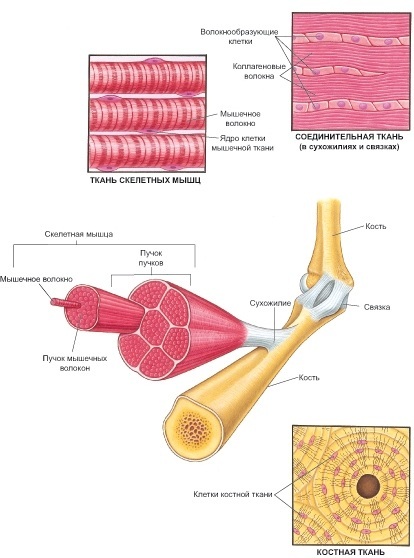
Joints are sedentary joints that hold certain parts of the skeleton together and also provide them with functional mobility. Cartilage tissue in the structure of the intervertebral discs makes it possible to maintain moderate mobility vertebrae, and guarantees the flexibility of the entire spinal column with minimal risk of severe injuries. For example, during physical exercise or heavy physical labor.
Muscle
The table below describes the structure of the skeletal muscles of the human musculoskeletal system, and also indicates the functional purpose of its individual segments.
| The structure of the musculature of the skeleton | Functions |
| Triceps | Extends the forearm in the area of the elbow joint. |
| Deltoid | Responsible for the mobility of the humerus. |
| Trapezius muscle | Lowers the scapula and raises the shoulder joints. |
| Latissimus dorsi | Allows you to freely pull the upper limb back and down while turning inward. |
| Gluteus maximus muscle | It extends the torso, makes it possible to perform bends in different directions, and also provides mobility of the hip joint. |
| Hamstring | Flexes and unbends the lower limb at the knee joint. |
| Achilles tendon | Provides functional mobility of the foot. |
| Quadriceps | Allows you to unbend the lower leg in the area of the knee joint while walking or running. |
| Sartorius | Takes part in flexion of the knee joint and turns the lower limb inward in the lower leg area. |
| Rectus abdominis muscle | Responsible for performing forward bends of the torso and retraction of the anterior abdominal wall. |
| Large muscle of the chest | Allows you to direct the hand to the body and turn the upper limb inward. |
| Circular muscle | Closes and opens the eyeball. |
| Biceps muscle | Flexes the tissues of the forearm in the area of the elbow joint. |
| Deep flexor | Provides functional mobility of the phalanges of the fingers. |
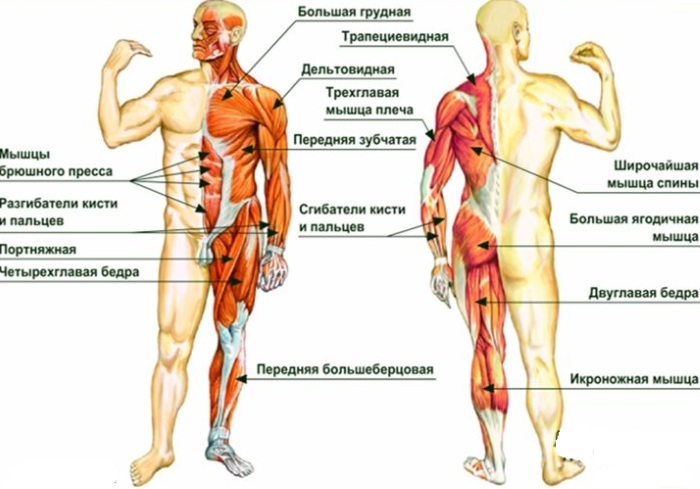
The aforementioned muscles of the musculoskeletal system are characterized by the ability to synchronize their functions, are distinguished by elasticity, a high level of extensibility and physical strength.
Diseases of the musculoskeletal system
The human musculoskeletal system, whose functions include protecting vital organs from damage, is susceptible to the development of a large number of pathologies. Diseases of the musculoskeletal system are congenital and acquired in origin.
Ankylosis
Ankylosis is a severe pathology of the musculoskeletal system that develops due to the fusion of bone or cartilage tissue connecting the joint with the bones of the upper or lower extremities. This disease is accompanied by bouts of acute pain in the localization of the pathological process. Discomfort increases during exercise.
The occurrence of ankylosis is associated with the negative effects of the following factors:
- chronic infections affecting the structure of the joint;
- previous limb injuries;
- consequences of gunshot and shrapnel wounds;
- osteomyelitis of bone tissue.
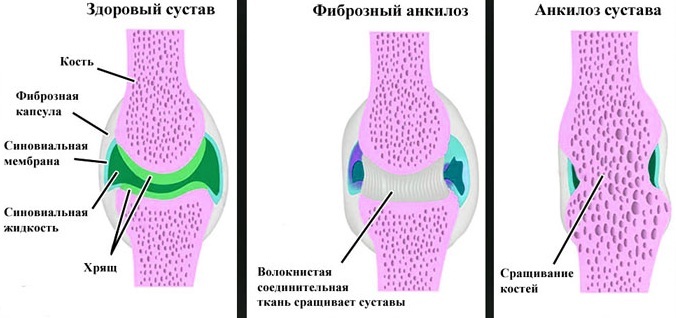 Treatment of ankylosis is carried out with the help of a surgical operation to remove fibrous and altered tissues that impair the functional mobility of the joint. Anti-inflammatory and antibacterial drugs are used.
Treatment of ankylosis is carried out with the help of a surgical operation to remove fibrous and altered tissues that impair the functional mobility of the joint. Anti-inflammatory and antibacterial drugs are used.
Arthritis
Arthritis is an inflammatory lesion of the joints of the musculoskeletal system. The disease is acute or chronic. This disease is accompanied by severe pain inside the joints, their deformation changes, complete or partial loss of the ability to move independently.
The reasons for the development of arthritis are not fully understood, but the presence of chronic infections of the body, genetic predisposition, difficult working conditions, constant hypothermia.
Dystrophy
Dystrophy is a severe pathology of the human musculoskeletal system, which disrupts the full development of muscle or bone tissue, depending on the type of metabolic disorders.
This disease is accompanied by the destruction of cells and the intercellular substance of the muscles, a deterioration in the metabolism of mineral substances in the bones. Dystrophy is congenital, when a person's process of assimilation of proteins, fats or carbohydrates is disturbed from birth, as well as acquired. In the latter case, the prognosis for the restoration of normal body weight is more favorable.
Osteoporosis
Osteoporosis is a systemic disease of human skeletal muscles with a chronic course. This pathology is accompanied by a decrease in the structural density of bone tissue against the background of a deterioration in its mineralization.
People with osteoporosis suffer from frequent fractures of various parts of the skeleton, are severely hunched over, and constantly complain of severe pain in the spine. The main danger of osteoporosis is that it proceeds without obvious symptoms until the decrease in the level of bone mineralization becomes critical.
Scoliosis
Scoliosis is a curvature of the spinal column, a violation of its normal anatomical shape. This pathology can be congenital, post-traumatic, or acquired in the process of independent life. Scoliosis can affect any part of the spine, disrupting the patient's posture, as well as provoking concomitant diseases of the internal organs. Treatment of severe forms of this disease associated with critical deformity of the vertebrae is performed surgically.
Flat feet
Flat feet is a disease of the lower extremities, which is characterized by a strong descent of its transverse and longitudinal arches of the foot. Pathology is accompanied by pronounced deformational changes in the tarsal bones, gait disturbance, pain after a long walk or long standing. Flat feet can lead to clubfoot and poor posture.
The human musculoskeletal system consists of the bones of the skeleton and muscle tissues, which ensure the execution of synchronous movements of all parts of the body. The lower and upper limbs, spine, skull, connective tissues perform supporting, protective, hematopoietic functions.
The musculoskeletal system is connected by bones, tendons and soft cartilage, which make the skeleton mobile, strong and flexible under critical loads. Muscle tissue is attached to the surface of the bones and is set in motion by innervation by peripheral nerves. Most diseases of the musculoskeletal system are associated with inflammatory processes in the structure of the joints, as well as impaired bone mineralization.
Video about the musculoskeletal system
The human musculoskeletal system:

